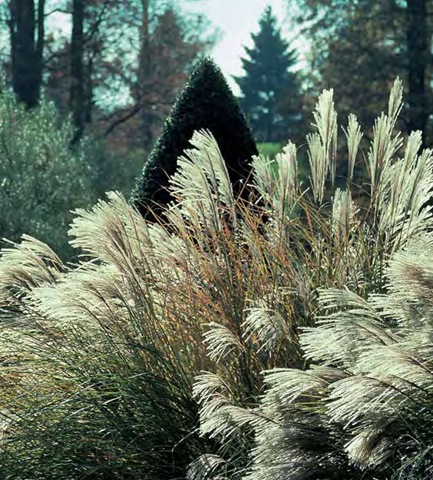OLD HERBALS USED THE WORD grass, variously spelled gres, gyrs, gwrs, to refer to almost any small green plant. We’ve since narrowed the meaning, and in today’s common language grasses are plants with long, narrow leaves. This broad definition typically includes a number of related botanical families: the true grasses (in the grass family, Poaceae), sedges (sedge family, Cyperaceae), rushes (rush family, Juncaceae), restios (res-tio family, Restionaceae), and cattails (cattail family, Typhaceae).
In addition to having narrow grasslike foliage, the above families all belong to a subgroup of flowering plants called monocotyledons (or monocots). The name of this subgroup refers to its members having one (mono) seed-leaf (cotyledon). The leaf veins of monocotyledons are typically parallel, and the leaf margins typically lack large teeth or notches, although some are very finely toothed or hairy. With the exception of the bamboos, which are true grasses, monocotyledons are herbaceous, meaning they don’t develop woody tissues. In contrast, dicotyledons (dicots), the opposing subgroup of flowering plants, have two seed-leaves, leaf veins that are netted, and leaf margins that are frequently toothed or cut, and they may be either woody or herbaceous. The word forb is a useful term referring to broad-leaved herbaceous plants exclusive of grasses and their close relatives.
Although it’s not difficult to develop a general sense of the differences between the botanical families of grasses, common names can often be contradictory and confusing. For example, panic grass, Panicum virgatum, is a true grass (Poaceae), but woolgrass, Scirpus cyperinus, and cottongrass, Eriophorum virginicum, are sedges (Cyperaceae). Soft rush, Juncus effusus, and wood rush, Luzula multiflora, are true rushes (Juncaceae), but spike-rush, Eleocharis acicularis, and bulrush, Schoenoplectus tabernaemontani, are sedges (Cyperaceae) The gardener’s term ornamental grasses is sometimes stretched to include all manner of narrow-leaved herbaceous plants including such things as Acorus (arum family, Araceae) and Liriope and Ophiopogon (lily family, Liliaceae); however, there’s no logical limit to this approach.
It’s not necessary to learn all the complex botanical family characteristics to appreciate grasses in the landscape or to use them effectively in design; however, a basic familiarity with family traits helps develop our eye for detail and makes identification easier. In addition to this, an understanding of grasses’ ecological and human cultural context can greatly enrich our appreciation of them in gardens and regional habitats.
The Grass Family, Poaceae
The true grasses belong to the botanical family known either as the Poaceae or the Gramineae. Both names are correct. Modern botanical nomenclature uses the standard ending -aceae for plant families, and family names incorporate a selected genus from within the family. The name Poaceae is a combination of the grass genus Poa and the standard ending. Gramineae is an older, descriptive name that has been conserved as an alternate by international agreement among plant taxonomists. This topic uses Poaceae for the grass family.

In late October, switchgrass, Panicum virga-tum, shares a wet edge in the New Jersey Pine Barrens with water willow, Decodon ver-ticillatus; red maple, Acer rubrum; highbush blueberry, Vaccinium corymbosum; and other moisture-tolerant species.
SIZE & DISTRIBUTION
True grasses, Poaceae, make up one of the largest families of flowering plants, comprising more than six hundred genera and approximately ten thousand species. It is surpassed in size only by the orchid family, Orchidaceae, which has a similar number of genera but nearly twice as many species, and by the aster family, Asteraceae, with more than nine hundred genera and nineteen thousand species. Size matters, but these numbers can be misleading, since grasses have by far the widest distribution of all flowering plant families. A truly cosmopolitan group, grasses grow on every continent and are part of all the major biomes of the terrestrial world. Grasses are found from mountain-tops to seashores, from the Arctic Circle south through temperate and tropical zones to Antarctica.
Despite their vast distribution, most grasses are plants of sunny, open places. With the exception of bamboos, grasses are relatively scarce in dense forests. True pioneers, they are among the first species to colonize newly created habitats, and they often play important roles in the successional process of reveg-etation. Although grasses may thrive in moderate, fertile environments, they are often best adapted to survival in extreme conditions: heat, cold, drought, low fertility, and/or toxicity. Grasses produce their seeds in copious quantities, and the seeds are equipped with energy reserves that allow them to quickly germinate and establish new plants. Grasses’ extensive fibrous root systems are extraordinarily efficient. The low-growing points of grasses allow the plants to sustain continual damage to top growth by fires or grazing animals.
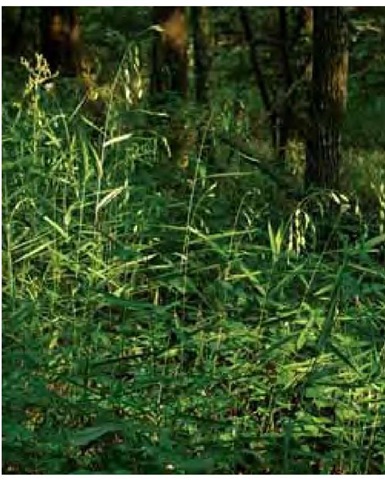
Growing in mid June under mixed pine and deciduous woodlands in Collin County, Texas, wild-oat, Chasmanthium latifolium, is one of relatively few grasses adapted to heavily shaded habitats.
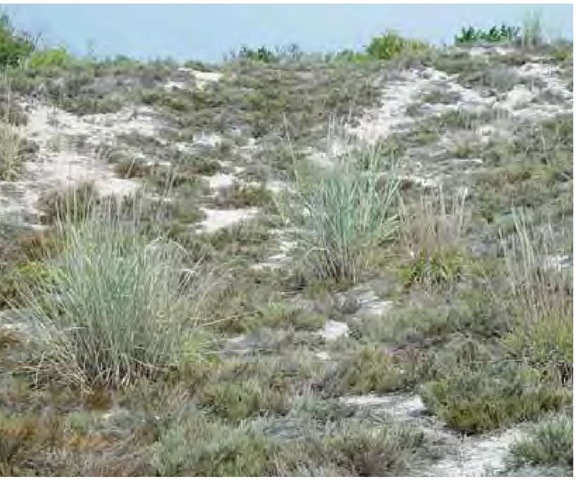
Coastal panic grass, Panicum amarum, and woolly false heather, Hudsonia tomen-tosa, are unfazed by the heat and exceptionally droughty conditions on coastal dunes in southern Delaware in late July.
GRASSES & HUMAN CULTURE
Including the cereal grains wheat, corn (maize in Europe), rice, rye, oats, barley, millet, and sorghum plus sugarcane among its members, the grass family is the most important to human civilization, which owes its spread to the development of grass-based agriculture. Human culture around the world has been shaped by grasses and products made from them. Grasses are the source of many aromatic and culinary oils, and are employed in the making of sake, wine, beer, whiskey, and many other alcoholic beverages. They’ve also provided a myriad of construction materials. Simple homes have been built of grass sods and roofed with grass thatch. Bamboos are still commonly used for framing and scaffolding, and in the manufacture of furniture and fencing.
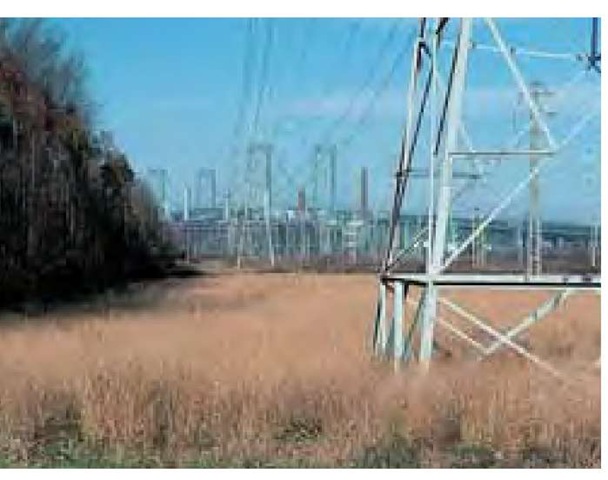
Switchgrass, Panicum virgatum, finds refuge under power lines in southern New Jersey. No one planted the grass: it is self-sown. The utility company’s management program eliminates woody plants that attempt to establish under the wires. The net effect is to produce the open, sunny habitat required by the grass. In past years, prior to the fire suppression that became humanly necessary due to increasing population, natural fires would have been the agents creating habitat for switchgrass.
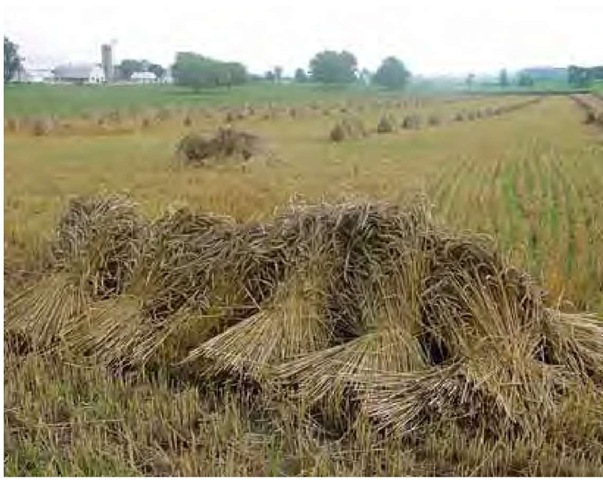
July harvest of winter wheat, Triticum aestivum, in Lancaster County, Pennsylvania. An annual grass, wheat is the most important food grain in the temperate zones. Of probably Middle Eastern origin, it has been grown for thousands of years, since the beginnings of agriculture. Nearly 500 million acres (ca. 200 million hectares) worldwide are devoted to wheat crops, primarily for flour production.
The reeds of wind instruments have traditionally been made from grasses. The highly manicured grassy lawn, though an ecological disaster by many estimates, is one of the most obvious of human cultural traditions involving grasses.
The destabilization of regional ecologies by human activity has been both good and bad for grasses. While humankind has virtually eliminated many grassland ecosystems including the North American tallgrass prairie, it has simultaneously created a huge amount of open, sunny habitat favorable to grasses. Though this has led to large-scale displacement and relocation of grasses, it has not been as destructive to them as it has been to less resilient groups. Modern circumstances, for example, favor grasses over orchids, which are often critically dependent upon long-evolved relatively stable habitats. The same physiological characteristics that make them fit for extreme conditions are responsible for grasses’ opportunistic behavior in destabilized environments and disturbed habitats. The sunny, open ground and relative absence of competition often present in newly constructed gardens and other designed landscapes offer ideal habitat for colonizing grasses.
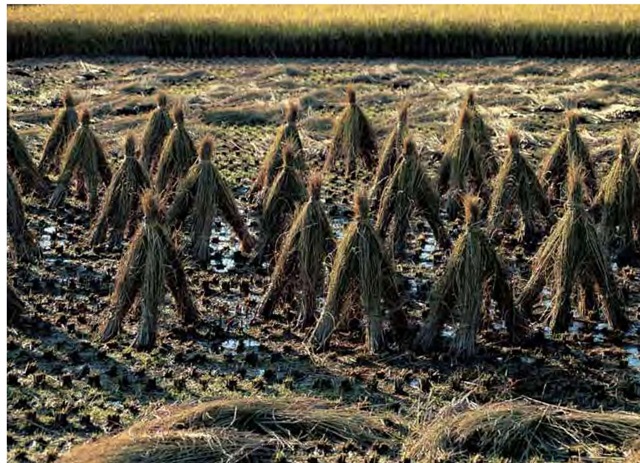
Harvested rice, Oryza sativa, in late October in central Japan. Rice is also an annual species, grown for its edible grain, for its use in making sake (rice wine), and for straw.
GRASS LIFE CYCLES
The grass family comprises both annuals and perennials. Many grass genera, such as Panicum, encompass both annual and perennial species. The majority of cereal crops including corn (maize), wheat, and rice are annuals, and as such complete their life cycle from seed to seed within one year or growing season. Perennial grasses typically flower and produce seed in a single season, although they may take longer; however, they continue to live for multiple years. Most grasses grown for ornament are perennials, although some perennials from warm climates behave as annuals when grown in colder environments.
ROOTS
A grass seedling typically produces an initial primary root that is short-lived. This root is soon supplanted by secondary roots, called adventitious roots, which arise from the lower portion of the stem. The secondary roots make up the bulk of the extensive, fibrous system characteristic of grasses. The highly efficient fibrous roots of grasses often extend to greater depths than the roots of other, larger plants. For example, the roots of big bluestem, Andropogon gerardii, have been observed growing 7 feet (2.1 m) into the earth, which exceeds the rooting depth of most mature trees.
STEMS
Although it’s entirely acceptable to speak of grass stems, the botanical term for a grass stem is culm. Culms are made up of solid joints called nodes and separated by segments called internodes. Nodes are the points of attachment for leaves (see above left). The internodes are typically hollow, although those of a few grasses such as corn, Zea mays, and sugarcane, Saccharum officinarum, are solid and pithy. Grass culms are typically cylindrical and round in cross section. Though some grass species have culms which appear somewhat flattened in cross section, none are distinctly three-angled like the sedges. Grasses are herbaceous plants with the exception of bamboos, which develop woody character from cells impregnated with hardening substances lignin and silica. This is different from the true wood produced by trees and shrubs, which represents layered, secondary growth.

A culm (stem) of wild-oat, Chasmanthium latifolium, with terminal inflorescence. Leaves are attached to the culm at nodes. Each leaf sheath surrounds the culm up to the point where the leaf blade diverges. The inflorescence is an open panicle with unusually large spikelets. Each spikelet contains multiple florets.
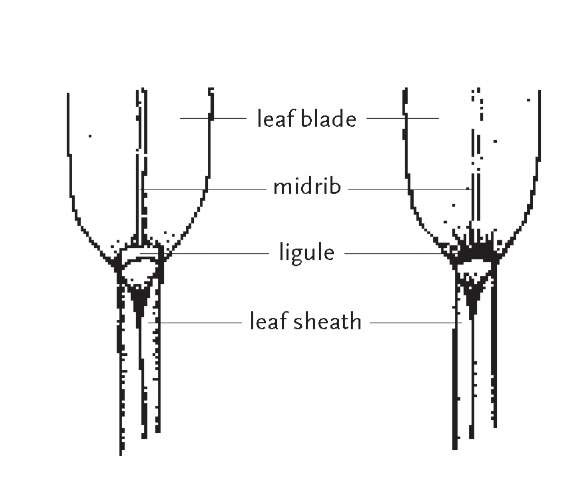
Grass leaves typically have ligules located at the juncture of the leaf sheath and leaf blade, on the side facing the culm. Ligules may consist of a thin membranaceous ridge (left) or a row of fine hairs (right).
LEAVES
Grass leaves arise from alternate nodes, forming two ranks (rows) ascending the culm. They are typically comprised of three parts: the sheath, blade, and ligule (see page 38 bottom). A sheath originates at a node and surrounds the culm, typically with overlapping margins. The blade is the flattened part of the leaf, beginning at the top of the sheath and continuing away from the culm. Leaf blades of grasses are typically narrow, with numerous parallel veins and a single larger median vein called a midrib. The blade margins are usually smooth; however, some are edged with minute teeth and can cause serious cuts. The ligule is a thin membranous ridge or small row of hairs located at the juncture of the sheath and blade on the interior side, facing the culm. The function of the ligule is uncertain, though it may serve to prevent rain from entering the sheath. Characteristics of ligules vary considerably, including their relative prominence and the nature of hairs when present, and these features are often critical to the precise identification of closely related grass species.
GROWTH
The active growing points (meristems) of most flowering plants are located at the tips of their stems and branches. Terminal growth of a stem or branch ceases if the meristem is destroyed, although growth may continue from a lateral meristem arising from a node. Grasses are unusual in having two types of meristems, one at the base of each leaf and another just above each node on the culm. These meristems allow grass stems and leaves to continue elongating even if their tips are grazed, cut, burned, or otherwise destroyed. The meristems at the nodes are also capable of one-sided growth, making it possible for grasses to right themselves after being trampled or flattened by storms.
In addition to stem and leaf growth, grasses spread from their bases by various types of lateral shoots, which are often called tillers. These lateral shoots arise from the axils of the lowermost leaves. In many grasses, the lateral shoots grow vertically within the leaf sheaths, resulting in a tufted (cespi-tose, often spelled caespitose) habit of growth. These grasses are commonly referred to as clump-forming types. Other grasses have lateral shoots that do not elongate vertically but instead grow through the side of the leaf sheath. These lateral shoots are called rhizomes, which typically run below the soil surface, or stolons, which run at or above the soil surface. Grasses spreading by rhizomes and stolons are commonly called running types. The distinction between clump-forming and running types is not absolute. Some grasses are clump-forming for all practical purposes, yet they may in fact spread slowly by rhizomes or stolons. Giant reed, Arundo donax, is an example of a grass that spreads by rhizomes (right). Buffalo grass, Buchloe dactyloides, spreads by stolons (see page 40), as do most of the common turfgrasses.
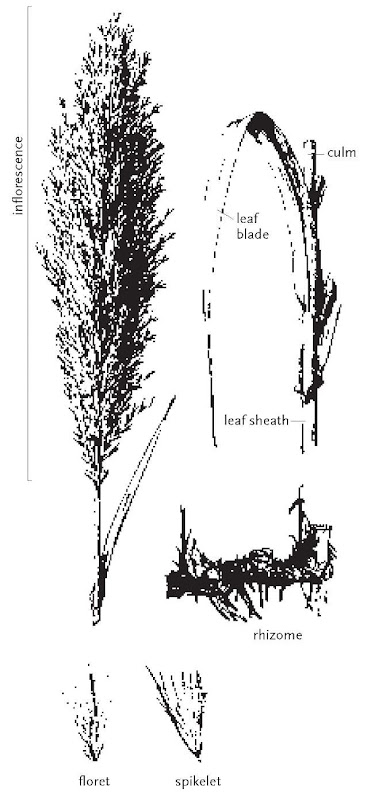
Giant reed, Arundo donax, is a running grass which spreads by stout rhizomes. New vertical shoots (culms) are produced from nodes on the rhizomes. The inflorescence is a closed panicle.
FLOWERS & INFLORESCENCES
The individual flowers of grasses are so small that they are sometimes difficult to distinguish with the naked eye. The floral magnificence of grasses owes to their delicately complex flower clusters, called inflorescences, which may comprise hundreds or even thousands of individual flowers.
Grasses are wind-pollinated plants, not dependent upon the conspicuously colorful broad-petaled flowers that are so attractive to insects and many gardeners. The ecological and geographic prosperity of grasses proves the efficiency of this strategy. Grasses are among the most highly evolved plants on the planet, and their evolution has been characterized by the reduction of some floral features. Compared to most flowering plants, grasses have flower parts that are greatly reduced in size or sometimes lacking entirely. Though some physical features of grass flowers are readily visible, many of the finer details necessary for technical identification require the use of a hand lens or microscope. If you’re ever offered the opportunity to view grass flowers through a good stereo dissecting microscope, accept the offer. There’s an incredible world of beauty in the details.
Grass flowers do not have typical sepals or petals. In their place, each flower has two scalelike structures called lodicules (left). Each flower has one ovary enclosing a single ovule that develops into the seed. Together, the ripened ovary and seed are called a grain, or caryopsis. Each grain contains endosperm, an energy reserve in the form of starch, and the embryonic grass plant, known as the germ. Two short stalks called styles project from the top of the ovary. Each style ends in a feathery stigma adapted to receive wind-borne pollen grains. The grass flower also includes three stamens, each consisting of a threadlike stalk known as a filament, to which is attached a pollen-producing appendage called the anther.
Each individual grass flower is typically enclosed and protected by two bracts. The lower, outer bract is called the lemma, and the upper, inner bract is called the palea. The grass flower with the lemma and palea is called a floret.
A spikelet consists of one or more florets attached to a small central axis, together with two basal bracts called glumes. The glumes or the lemmas sometimes end in long bristlelike structures called awns. Additional hairs or bristles are often associated with spikelets and, together with the awns, these structures are primarily responsible for the dramatic translucent properties of grass inflorescences.
The basic pattern of spikelets consisting of two glumes and one to many florets is consistent among the grasses; however, variations in the size, shape, sexual complement, and number of parts, or the inclusion of additional structures, results in seemingly endless permutations that make the technical identification of grasses relatively difficult. Full discussion of floral morphology is beyond the scope of this topic; however, for interested readers several topics on grass structure and identification are included in the bibliography.
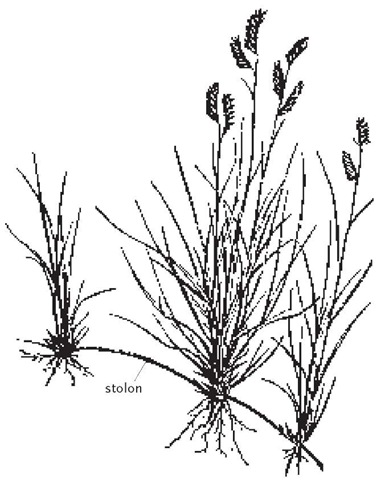
Buffalo grass, Buchloe dactyloides, spreads by stolons which produce new plants at the nodes. This species is dioecious, having male and female inflorescences on separate plants. Plants shown here are male.
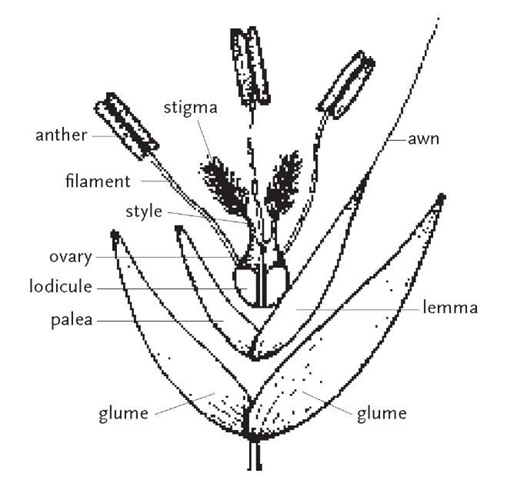
A grass spikelet containing a single floret, vertically expanded for purposes of illustration.
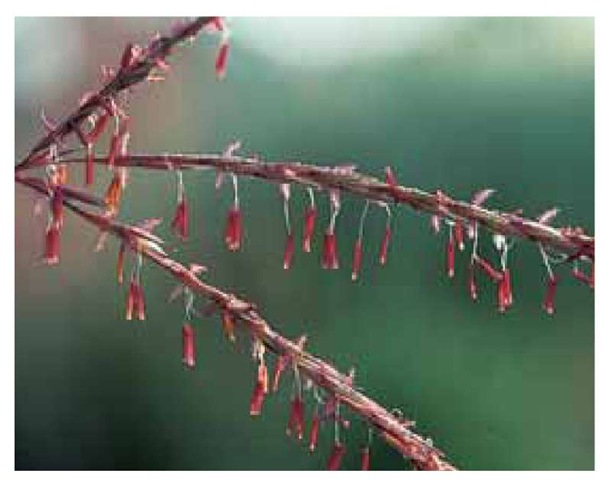
Red anthers suspended from threadlike filaments and feathery pink stigmas are clearly visible in this inflorescence of big bluestem, Andropogon gerardii, in early September.
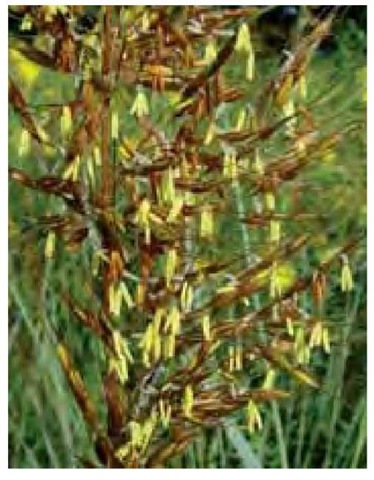
The individual flowers (florets) of grasses are often difficult to distinguish with the naked eye, partly because of their small size and partly because they are concealed within bracts associated with the spikelet. In this mid-September photo, bright yellow anthers of Indian grass, Sorghastrum nutans, are readily apparent. The feathery white stigmas are less obvious. The copper hues of the various stalks, bracts (including glumes, lemmas, paleas), and other appendages (including the long awns) combine with the yellow of the anthers for a relatively colorful ensemble.
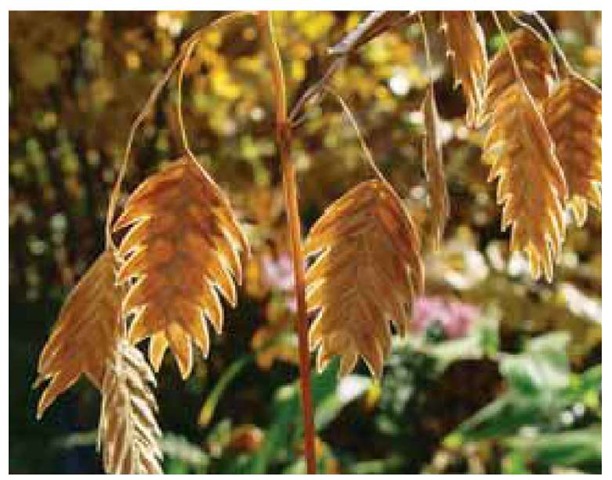
Suspended from the branches of an open panicle, the spikelets of wild-oat, Chasmanthium latifolium, are among the largest in the grass family. Each spikelet contains multiple florets.
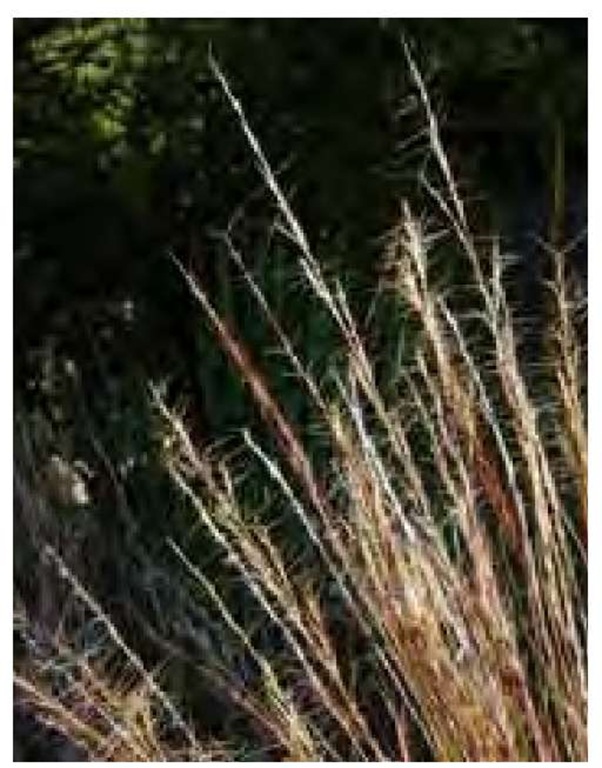
Awns are bristlelike or needlelike appendages that extend from the glumes, or lemmas, of grass spikelets. Diverging almost horizontally, the conspicuous awns of purple three-awn, Aristida purpurea, catch the early April light in California.

The fringed awns of needle grass, Stipa barbata, are exceptional, reaching a length of 7 inches (18 cm) or more. Awns contribute significantly to the drama and luminous qualities of grass inflorescences, as evident in this late-July photo in England.
Though it is possible to distinguish the majority of cultivated grasses from one another without a thorough mastery of structural details, it is useful to be able to recognize a spikelet and to be aware of the variation in the structure and form of grass inflorescences. There are three basic types of simple inflorescences: spikes, racemes, and panicles (left). Common to all of these is a readily apparent main axis called a rachis. A simple spike has individual spikelets attached directly to the rachis. Wheat, Triticum aestivum, and bottle-brush grass, Elymus hystrix, are examples of simple spikes.
A simple raceme has individual spikelets attached to the rachis by short stalks. Semaphore grass, Pleuropogon californicus, an annual species, is one of relatively few examples of a simple raceme.
In a simple panicle, the spikelets are attached to the ends of stalks that branch, often repeatedly, from the rachis. The genus Panicum is characterized by this type of inflorescence, which is by far the most common among grasses. There are two general types of panicles: open and closed. The branching of open panicles is loose and airy, as in the examples of Panicum; purple loveg-rass, Eragrostis spectabilis (left); and wild-oat, Chasmanthium latifolium (page 38). The branches of closed panicles are upright and held closely to the rachis, as with giant reed, Arundo donax (page 39).
The inflorescences of many grasses are actually combinations of one or more of the three simple types and are termed compound inflorescences. For example, the compound inflorescence of side-oats grama, Bouteloua curtipen-dula, is a raceme of spikes (page 43). Miscanthus inflorescences are panicles of racemes (page 44).
Although the inflorescences of most grass species consist of spikelets with bisexual florets (having both male and female reproductive parts), some, such as wild rice, Zizania aquatica, and Tripsacum species, have male and female spikelets located in different portions of the inflorescence. Less commonly, grass species are dioecious, meaning individual plants either have inflorescences of all female spikelets or inflorescences of all male spikelets. Pampas grass, Cortaderia selloana, and buffalo grass, Buchloe dactyloides (page 39), are examples of dioecious grasses.

The three basic types of simple grass inflorescences.
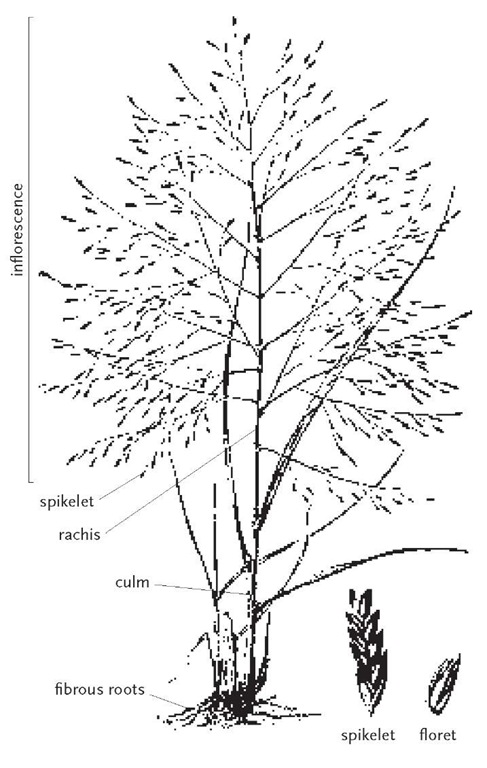
The panicle is the most common type of grass inflorescence. The inflorescence of purple lovegrass, Eragrostis spectabilis, is typical of an open panicle.

An open panicle of switchgrass, Panicum virgatum, in mid September.
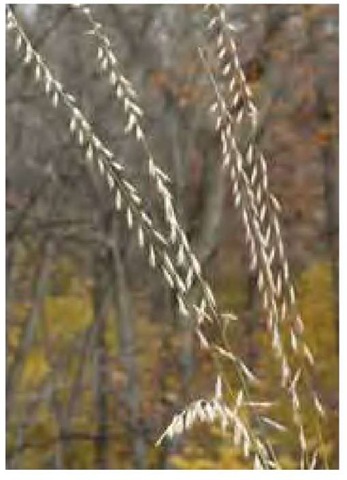
Inflorescences of side-oats grama, Bouteloua curtipendula, are dry and parchment-colored in late November in northern Delaware.
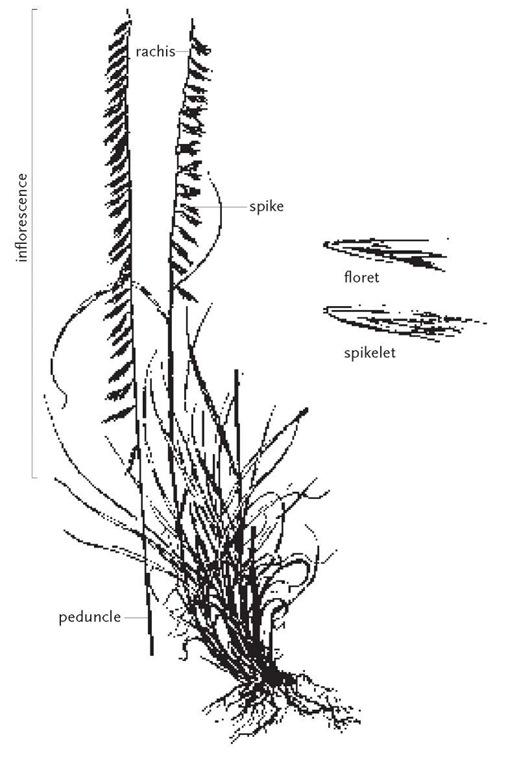
The compound inflorescence of side-oats grama, Bouteloua curtipendula, is a one-sided raceme of spikes. Each spike contains multiple spikelets. The peduncle is a typically leafless extension of the culm, supporting the inflorescence.
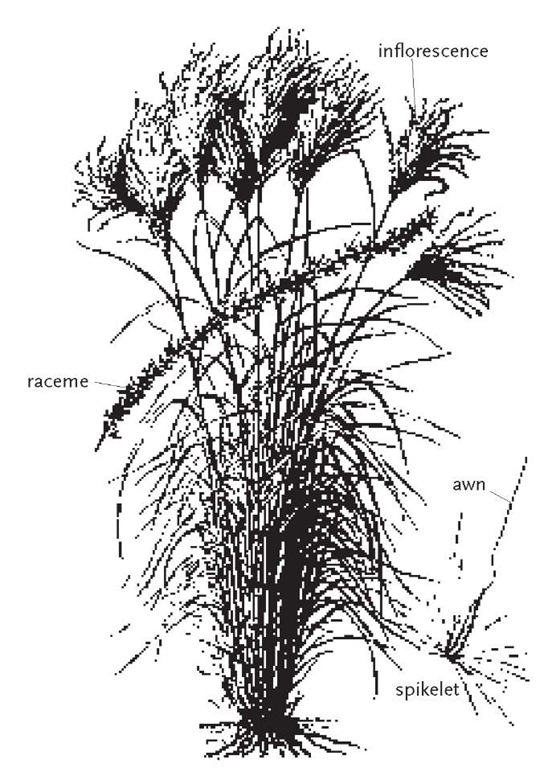
The inflorescences of Miscanthus sinensis are compound panicles consisting of numerous pencil-thin racemes. Fine, translucent hairs extending from the base of each tiny spikelet are primarily responsible for the inflorescence’s feathery appearance and extraordinary luminous qualities.
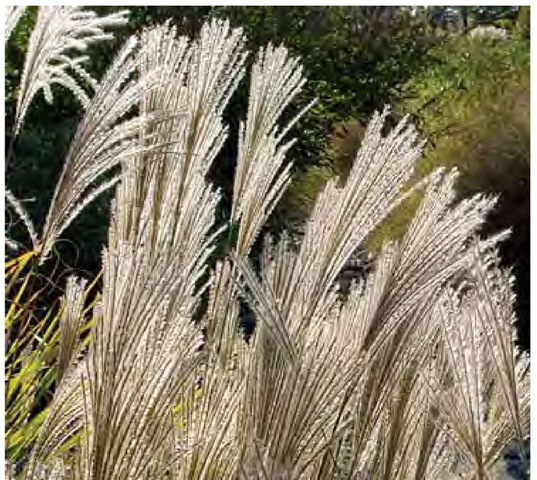
Compound inflorescences of Miscanthus sinensis are illuminated by the late-October sun in Maryland.
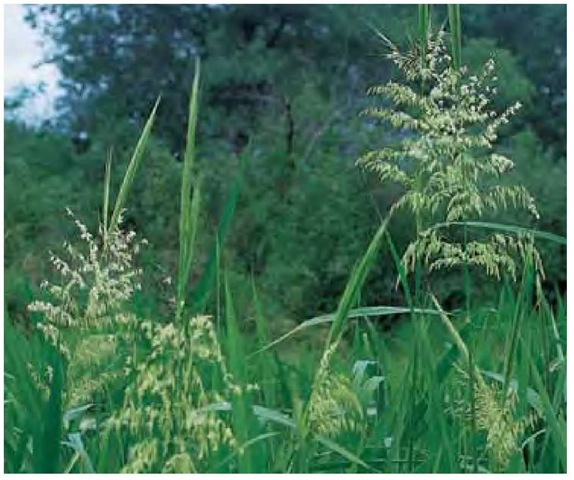
The stately inflorescences of wild rice, Zizania aquatica, have male spikelets in the lower portion and female spikelets above.

Dark red anthers extend from the upper, male spikelets of Florida gama grass, Tripsacum floridanum.
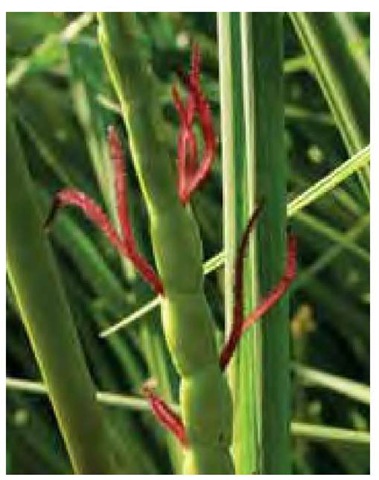
Huge by grass standards, the bright red stigmas of eastern gama grass, Tripsacum dactyloides, extend from female spikelets located only in the lower portion of the inflorescence.
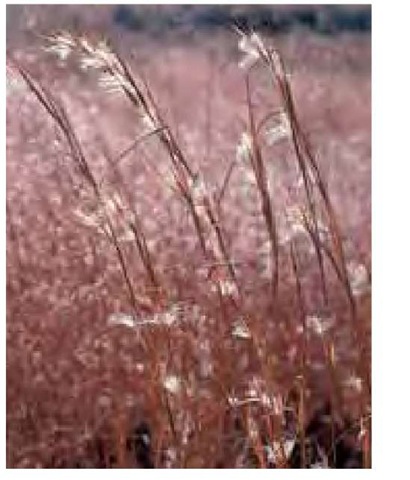
Broom-sedge, Andropogon virginicus, is another example of lateral inflorescences arising from nodes. Unlike the racemose inflorescences of little bluestem, Schizachy-rium scoparium, those of broom-sedge are not held out from the culm on extended peduncles but instead are tightly clustered at the nodes.
Grasses in the genus Tripsacum also have male and female spikelets separated on the same inflorescence, with male spikelets in the upper portion.
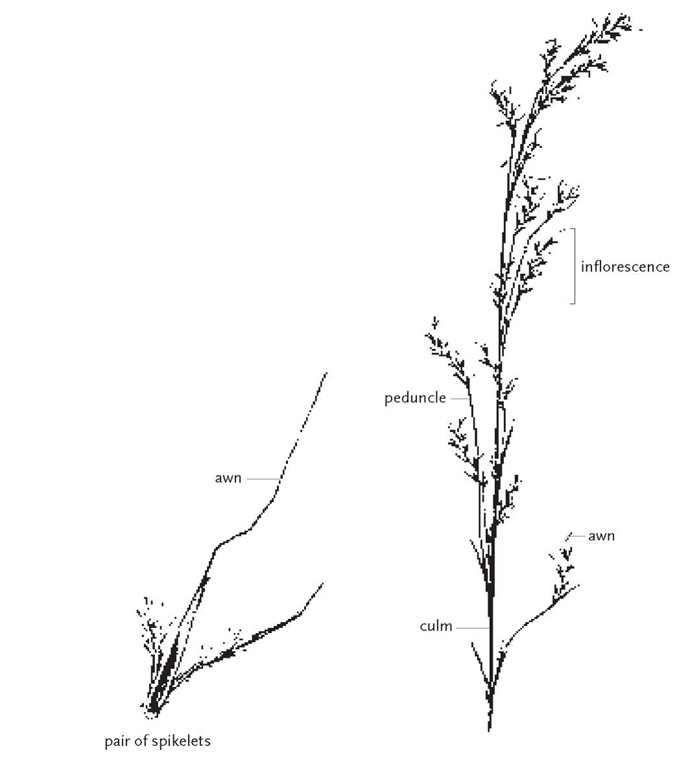
Although large terminal inflorescences are common among grasses, some species produce multiple lateral inflorescences along the length of the culm. Little bluestem, Schizachyrium scoparium, is an example of this, producing racemose inflorescences attached to separate peduncles arising from lateral nodes.
The Sedge Family, Cyperaceae
Though the sedges are fewer in number than the grasses, they are a relatively large family of approximately 115 genera and thirty-six hundred species, nearly all of which are perennial. The family name Cyperaceae is derived from the genus Cyperus.
Like grasses, sedges are a cosmopolitan group, found in most parts of the world. They do not colonize quite as actively as grasses do, but they do play important roles in soil stabilization. Most sedges prefer sunny habitats with moderate to high moisture, although some sedges are adapted to hot, dry environments and others are at home in densely shaded forests.
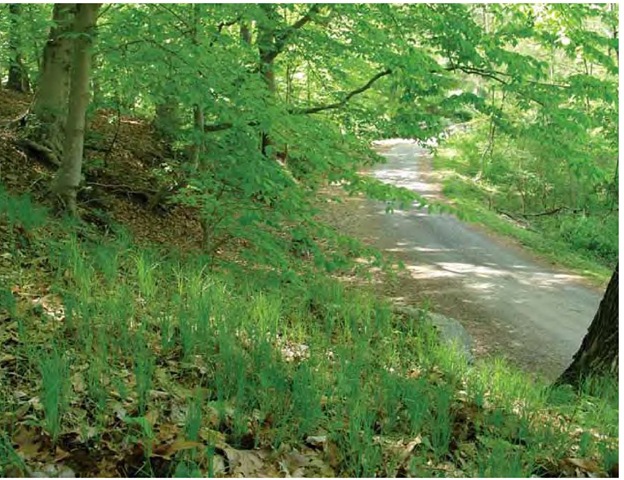
Almost lawnlike in appearance, Pennsylvania sedge, Carexpensylvanica, spreads over a wooded slope in northern Delaware in mid May. This highly adaptable running sedge occurs in a wide range of habitats, from moist woodlands with rich organic soils to sunny openings in sandy woodland environments.
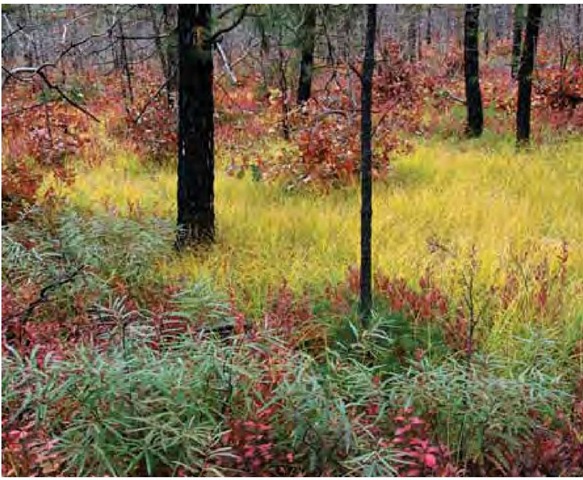
Carexpensylvanica becomes a carpet of gold in late October in the New Jersey Pine Barrens. It is covering the ground in open, sunny patches of a mixed pine-oak woods that burned the previous year. The soil is almost pure quartz sand: low in fertility and exceptionally dry in summer’s heat. The sedge is a well-adapted component of this fire ecology, filling its niche among other fire-tolerant and drought-tolerant species including pitch pine, Pinus rigida; blackjack oak, Quercus marilandica; sweet fern, Comp-tonia peregrina; and numerous low blueberries, Vaccinium, and huckleberries, Gaylus-sacia.
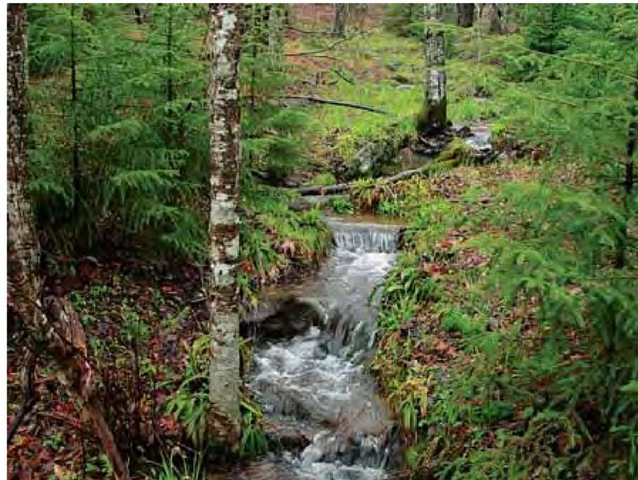
Lined with birch and spruce, this rocky West Virginia mountain stream provides ideal habitat for two shade and moisture-loving species: plantain-leafed sedge, Carexplantaginea, and Fraser’s sedge, Cymo-phyllus fraserianus, photographed in an early May rainstorm.
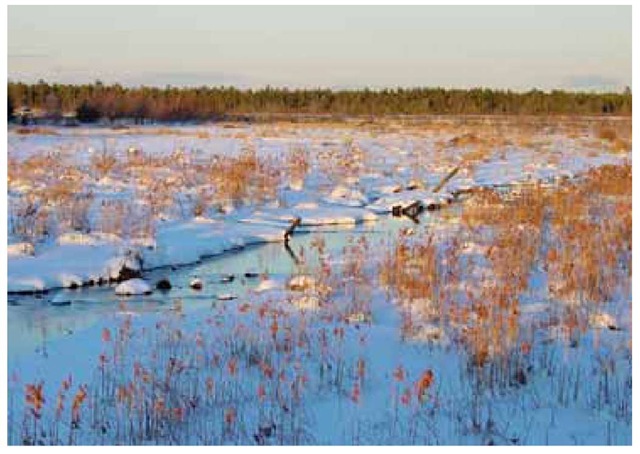
Woolgrass, Scirpus cyperinus, generally prefers moist, sunny environments, as in this view of a former cranberry bog at Whitesbog in the New Jersey Pine Barrens, on the last day of December.
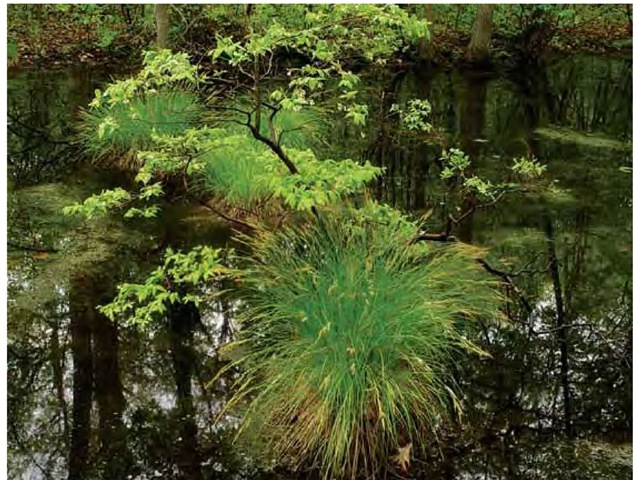
Tussock sedge, Carexstricta, is almost always found growing in standing freshwater habitats, though it will tolerate much drier conditions. It tends to grow in remote clumps in highly shaded environments, and often in tightly packed colonies in sunnier habitats. Shown here in mid May in a wooded wetland in New York State.
COMPARING SEDGES & GRASSES
Sedges can be distinguished from grasses by a few readily apparent vegetative characteristics. The popular saying “sedges have edges” is true and useful: unlike the cylindrical culms of grasses, sedge stems are triangular in cross section, and their leaves are three-ranked (arranged in three rows). Leaf blades of sedges are very grasslike; however, ligules are either entirely lacking or very much reduced. The leaf sheaths of sedges are closed (fused) around the stem, unlike the split, overlapping sheaths of grasses which can be easily pulled away from the culm. Whereas grass culms have hollow internodes, sedge stems lack nodes and are solidly filled with pith.
Like grasses, sedges have fibrous root systems. Though some sedges are tufted in their growth and remain as well-defined clumps, the majority spread by rhizomes or stolons, and many are capable of forming extensive mats.
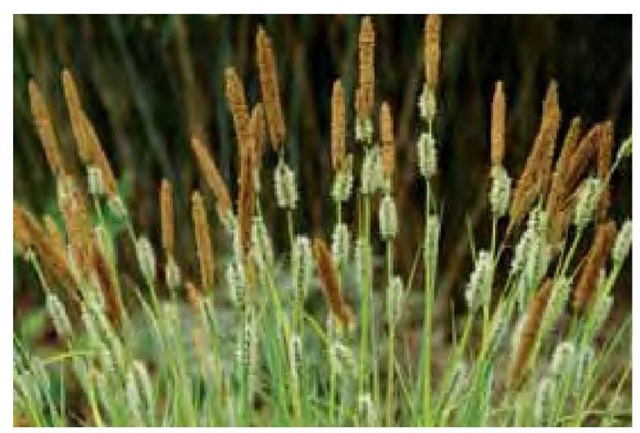
Inflorescences of tufted sedge, Carexelata, have female spikes (white) and male spikes (light brown) attached to the same peduncle.

The woolly inflorescences of woolgrass, Scirpus cyperinus, owe their distinct appearance to tiny red-brown bristles associated with each of the myriad individual flowers.
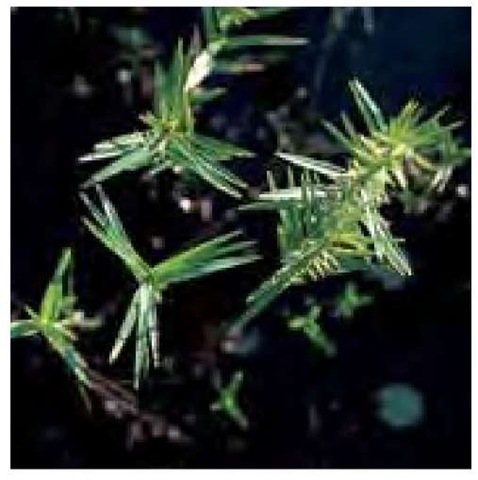
The three-ranked leaf arrangement characteristic of sedges is exceptionally clear in this top-down view of three-way sedge, Dulichium arundinaceum
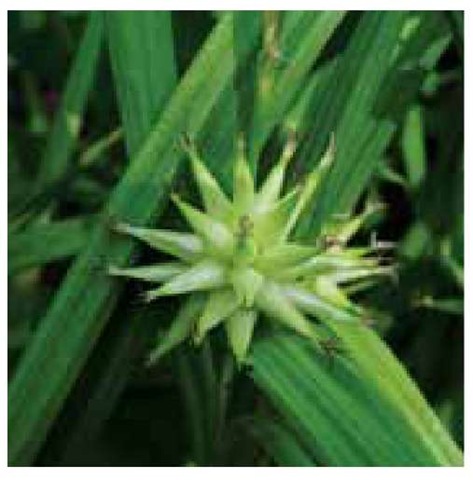
Gray’s sedge, Carexgrayi, is also called mace sedge due to the macelike appearance of the clustered utricles that make up the female portion of each inflorescence.
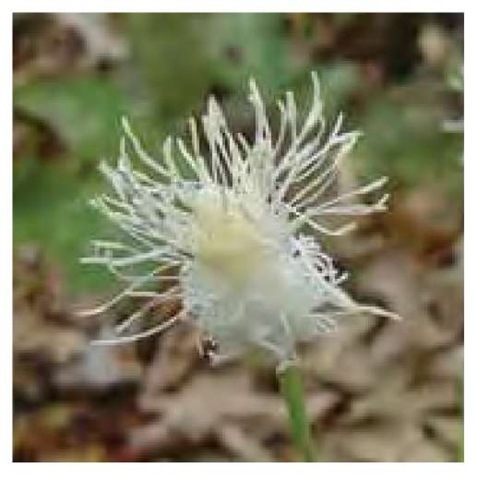
The conspicuously white terminal inflorescences of Fraser’s sedge, Cymophyllus fraserianus, have female flowers at bottom and male at top. The branched stigmas of the female flowers and the light yellow anthers of the male flowers are readily apparent.
Also like grasses, sedges are wind-pollinated, and the individual flowers are typically inconspicuous and without recognizable sepals and petals. Flowers are often but not always grouped in spikelets. Sedge inflorescences are comprised of flowers or spikelets arranged in various spikes, umbels, or panicles; however, few are as visually dramatic as the inflorescences of grasses, in part because they lack the highly translucent awns and hairs of grasses. Some inflorescences are conspicuously attractive in their own unique ways. Reduced leaves or bracts are often present at the base of the sedge inflorescence, and while typically green, these may be bright white, as in the genus Rhynchospora. The inflorescences of black-flowered sedge, Carex nudata, are nearly black, and those of crimson-seeded sedge, C. baccans, turn deep red as seeds mature.
Unlike the majority of grasses, many sedges, including those in the large genus Carex, have male and female flowers grouped in separate spikes within the inflorescence of a single plant. The female flowers of Carex are commonly enclosed in a saclike structure called a perigynium or utricle, which may be enlarged and conspicuous as in Gray’s sedge, C. grayi.
Sedges may lack colorful flowers, but their foliage is often richly hued. Sedges are often evergreen or semievergreen even in cold climates, and their leaf colors encompass a wide range of green, yellow-green, and blue. Many of the New Zealand Carex species are naturally brown or red.
SEDGES & HUMAN CULTURE
Especially when compared to grasses, sedges are unimportant as human food sources or as feed for domesticated animals. The relatively few edible sedges include Chinese water-chestnut, Eleocharis dulcis, and chufa or earth-almond, Cyperus esculentus var. sativus, which are cultivated for their tubers. Sedges more commonly provide raw materials for various products. The papyrus paper of classical antiquity was made from stems of Egyptian paper reed, or papyrus, C. papyrus. Many sedges, most notably bulrushes in the genus Schoenoplectus, have been employed in the construction of primitive dwellings, basketwork, mats, and chair seats. The fluffy heads of cottongrasses in the genus Eriopho-rum have been used for pillow stuffing, and the roots of galingale, Cyperus lon-gus, provide aromatic oils used in perfumery.
The Rush Family, Juncaceae
Rushes are a small family of worldwide distribution, typically inhabiting wet or moist places in temperate and subarctic regions. Like grasses and sedges, rushes are wind-pollinated and their flowers are small and subtle in their coloration, but that’s where the similarity ends. Though all their parts are relatively minute, rush flowers bear a close resemblance to those of more typicalmonocots such as lilies. Rush flowers are most often bisexual, with six tepals (the term for nearly identical sepals and petals) arranged in two whorls, six stamens, and an ovary with three stigmas.
The family includes fewer than four hundred species in only eight genera. All rushes are herbaceous with the exception of the shrubby South African genus Prionium. The family name is derived from the genus Juncus, which is by far the most extensive in the family. Luzula is the other commonly encountered genus, and the two are quite distinct from one another.
Plants belonging to Juncus are called rushes, and their stems are typically erect, cylindrical, solid, and without nodes. Typical leaves are absent: the green (or blue-green) stems carry on the photosynthetic process and are usually evergreen. Flowers are clustered in branched inflorescences called cymes, which are usually attached directly to the stem, nearer the top. Juncus species typically flower in summer. They are usually found in wet sunny habitats, although some are adapted to sunny arid places.
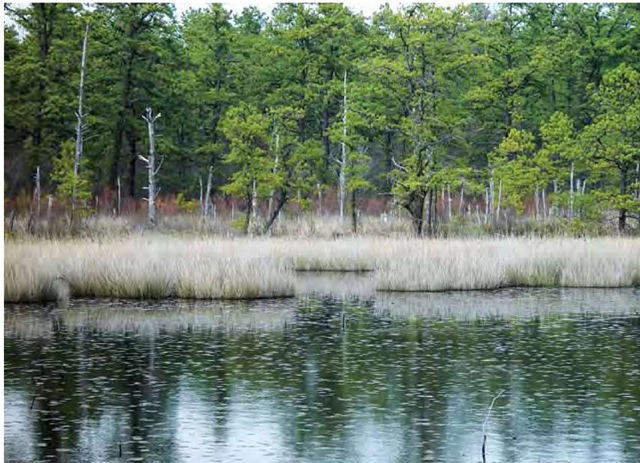
Soft rush, Juncus effusus, grows in bands in full sun and shallow water near the margin of a former cranberry bog at Whitesbog in the New Jersey Pine Barrens. The pattern of the rush reflects the remains of subsurface grading and drainage that was engineered and constructed nearly a century ago.
Plants belonging to Luzula are called wood rushes, and these have leaves with enclosed sheaths and flat, grasslike blades. Wood rushes are typically evergreen, and their leaf margins are often fringed with fine hairs. The leaves form basal rosettes, with reduced leaves continuing up the generally erect stems. Inflorescences are terminal and often combine the characteristics of panicles, umbels, and heads. Luzula species are typically spring-flowering and, as the common name suggests, wood rushes prefer shady, woodland habitats, usually of moderate moisture.
The rush family is of minor economic importance as the source of various fibers and binding materials. The leaves of the South African palmiet, Prio-nium palmitum, are the source of a strong fiber called palmite. Sea rush, Jun-cus maritimus, is the source of binding material known as juncio. Stems of the common or soft rush, Juncus effusus, which occurs throughout North America and Eurasia, are widely used to make baskets, chair seats, and various types of mats, including traditional Japanese tatami.
Green, leafless cylindrical stems ofJuncus effusus are silhouetted in the smooth surface of New Jersey Pine Barrens waters. The orbicular leaves of fragrant waterlily, Nym-phaea odorata, are dramatic in contrast.
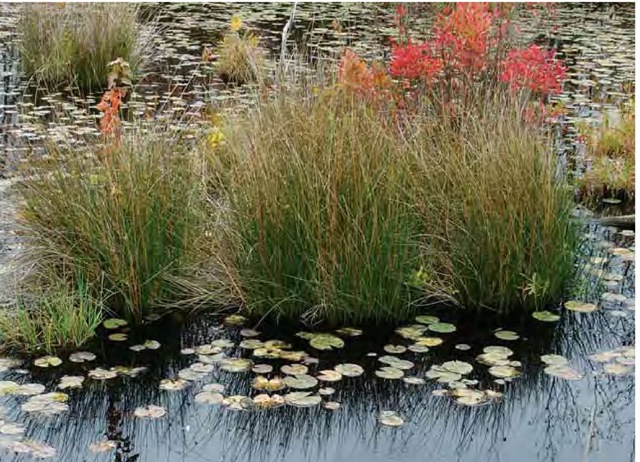
Green, leafless cylindrical stems of Juncus effusus are silhouetted in the smooth surface of New Jersey Pine Barrens waters. The orbicular leaves of fragrant waterlily, Nym-phaea odorata, are dramatic in contrast.
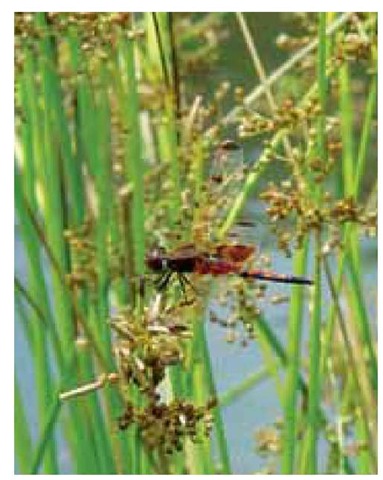
Juncus effusus offers the perfect perch for the calico pennant dragonfly, Celithemis elisa, at the margin of a northern Delaware pond.
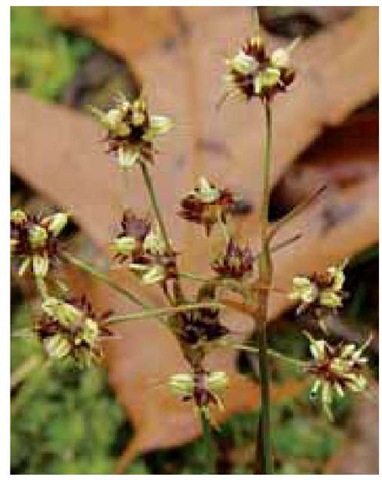
Common wood rush, Luzula multiflora, blooms in late April in a northern Delaware beech-oak forest. Yellow anthers and red-brown tepals are visible to the naked eye.
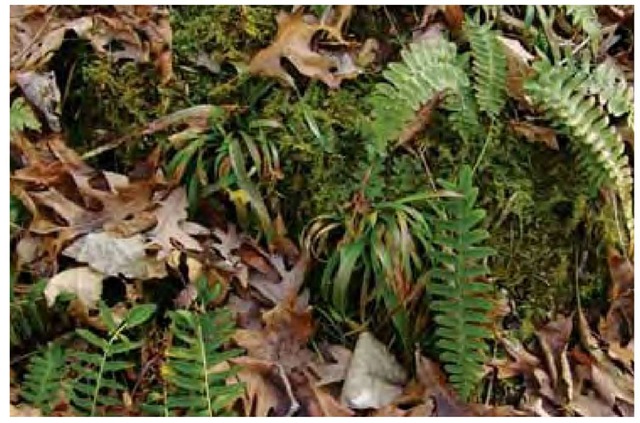
A mossy bank in deciduous forest in Virginia provides ideal habitat for wood rush, Luzula acuminata, and Christmas fern, Polystichum acrostichoides.
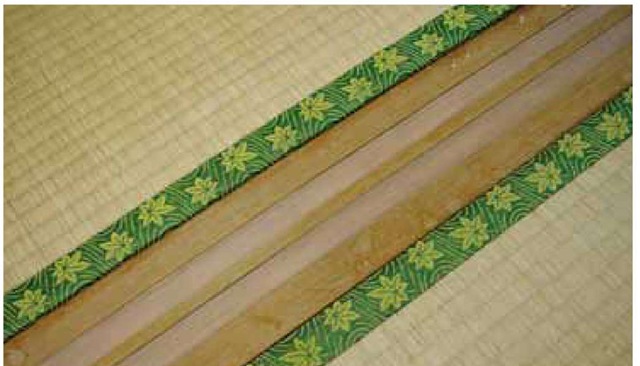
Tatami floor mats with decorative cloth edging fit precisely against a wooden channel for a sliding screen in a traditional Japanese structure. The durable outer covering (tatami omote) of the tatami is tightly woven from stems ofJuncus effusus, soft rush or, as it is known in Japan, igusa.
The Restio Family, Restionaceae
Restios include nearly five hundred perennial herbaceous species in as many as fifty-five genera, and these are almost entirely restricted to the Southern Hemisphere. Although they occur in Chile, Southeast Asia, Madagascar, and New Zealand, restios are best represented in the winter rainfall regions of Australia and South Africa, which together are home to nearly forty genera and four hundred species. Restios are an integral part of the fynbos flora of South Africa’s Cape Floral Region, where they are commonly called Cape reeds. Fyn-bos literally means fine bush and refers to a vegetation type characterized by the presence of restios, heaths, and proteas. In this context restios largely take the place of true grasses, especially on the most nutrient-poor soils.
Like the true grasses, sedges, rushes, and cattails, restios are monocots, and they are most often rushlike in their appearance, although some have branched stems and bear a superficial resemblance to horsetails, Equisetum. The high silica content in the cells of many restios contributes to a shiny stiffness that is also horsetail-like. Like rushes in the genus Juncus, most restios lack normal leaves with flat leaf blades. When present, leaves are generally reduced to sheaths present at the nodes or are clustered at the base of stems. The leaf sheaths are often leathery and tan, gold, or cinnamon-brown in color, and can be rather striking in appearance. Photosynthesis is carried on by the mostly evergreen stems, which are most often cylindrical, although some are flattened, tetragonal, or oval in cross section. Unlike the stems of rushes, restio stems contain nodes and internodes, and the internodes may be solid, spongy, or hollow. Most restios are tufted and clump-forming, although some have slowly spreading rhizomes. The roots may be fleshy or thin and wiry.
Restios are wind-pollinated, and the individual flowers are small, green or brown in color, often with three to six tepals in two whorls, like true rushes. The flowers are typically grouped in spikelets which in turn comprise loose inflorescences, some of which can be of dramatic size. Most restios are dioecious, with male and female flowers on separate plants. Due to the unisexual nature of the flowers and associated bracts, male and female plants of the same species are often strikingly different in appearance from one another, making identification and classification of this family quite challenging.
The family name is derived from the genus Restio, which has as its root the Latin restis, meaning rope. The family is of no economic importance as a food source; however, a few species have been traditionally important as the source of thatching material. In South Africa, primitive homes as well as Cape-Dutch dwellings have long been thatched with dekriet, the common name for the thatching reed, Thamnochortus insignis. In addition to their use in thatching, some restios such as broom-reed, Elegia capensis, have been used for sweeping.
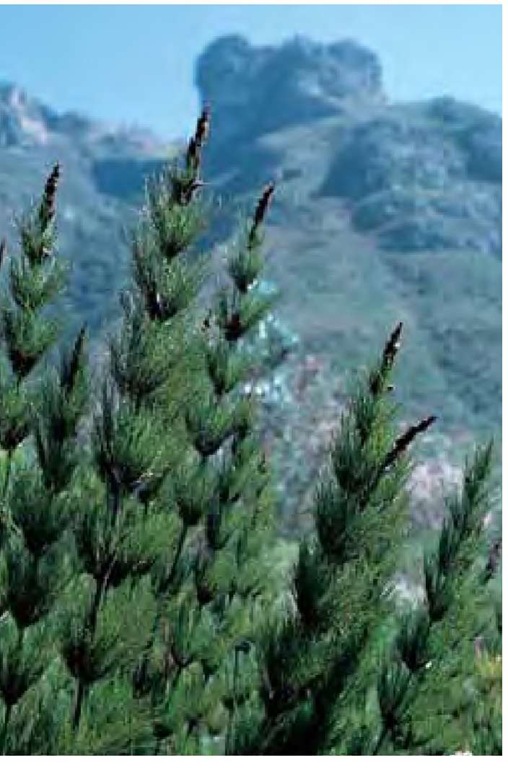
Table Mountain is visible in the background in this early September (spring) view of broom-reed, or horsetail restio, Elegia capensis, growing at the Kirstenbosch National Botanical Garden in Cape Town, South Africa. This restio has green stems that are finely branched in whorls at the nodes, bearing a strong resemblance to horsetails, Equisetum, although the two are not related.
Restios are also the source of many unique stems and seedheads which are important to the international cut-flower trade.
Many restios have great ornamental appeal, sometimes rivaling the textures and graceful luminosity of the true grasses. Though few, if any, are winter hardy in colder temperate climates, they are well adapted to the heat and periodic drought typical of the world’s Mediterranean regions, including California. Restios have seen a huge increase in their popularity as garden subjects since the 1980s attributable in large part to breakthrough research at the Kirstenbosch National Botanical Institute in Cape Town, South Africa. By closely observing the dynamics of the fynbos, which is a fire ecology, Kirstenbosch scientists determined that smoke from naturally occurring fires is a critical factor in breaking dormancy and stimulating seed germination of many restios. They have since developed a seed-priming method that employs fynbos-smoke-saturated water. This research has had a profound effect on the propagation and commercial availability of many restios. There are literally hundreds more to draw from.
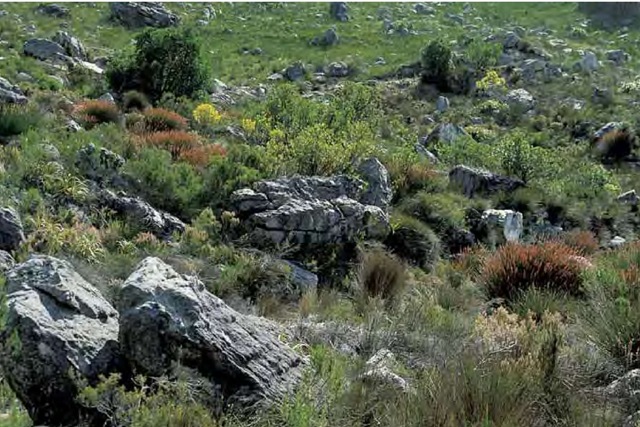
Fynbos vegetation in the Hottentots Holland Mountains of South Africa’s Cape Region comprises a number of restio family members including golden-curls, Elegia equiseta-cea, which are adapted to this low-nutrient environment subject to frequent fires.
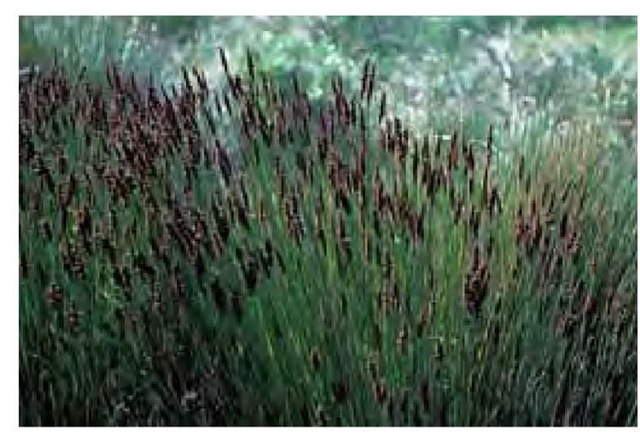
The leafless, cylindrical green stems and tightly clustered small brown flowers of Cape rush, Chondropetalum tectorum, are quite rushlike; however, this striking plant is one of nearly five hundred species in the restio family, Restionaceae. Photographed in late August (winter) in open, sunny, moist habitat on the Cape of Good Hope in South Africa.
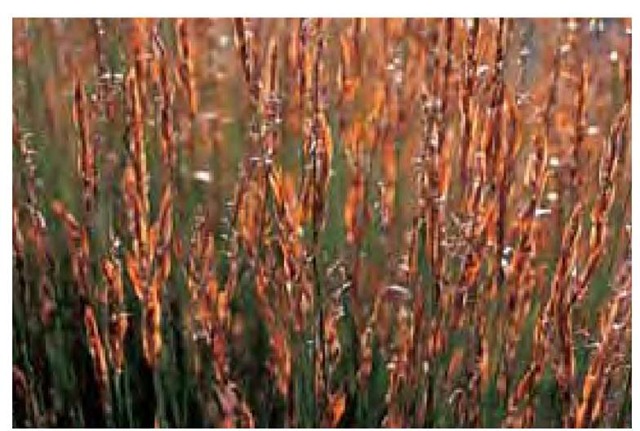
Conspicuous bracts of golden-curls, Elegia equisetacea, catch the afternoon sun in mid September (early spring) in Hottentots Holland Mountains.

Locally known as dekriet, thatching reed, Thamnochortus insignis, is used to restore the roof of this historic Cape-Dutch dwelling in South Africa’s Cape Region. If properly installed, this roof will last twenty years or more.
The Cattail Family, Typhaceae
The cattail family includes only one genus, Typha, and fifteen or fewer species, yet it is commonly represented in freshwater and slightly brackish habitats throughout the world’s temperate and tropical regions. Variously known by the common names cattail, cat-tail, bulrush, bullrush, and reed-mace, all members of this family are herbaceous perennials. The species are variable and prone to introgressive hybridization, which has contributed to taxonomic disagreement about the precise number of Typha species.
Cattails prefer shallow water, growing from 2 to 8 feet (60-240 cm) in height at the margins of ponds, rivers, and lakes, and spreading by stout rhizomes to form large colonies in swamps and marshlands. They are very adaptable and can survive extremes of temperature and periods of drought. Although sometimes considered weeds in managed wetlands, cattails provide important nesting materials and cover for birds and are homes to numerous insects and amphibians. They are critical to healthy nutrient cycles in many marshy habitats and are increasingly valued for their role as filtering agents in polluted wetlands.
Cattails spread by thick rhizomes, often forming dense stands such as this colony of Typha latifolia in Wellfleet, Massachusetts, photographed on Christmas Day.

Cattails spread by thick rhizomes, often forming dense stands such as this colony of Typha latifolia in Wellfleet, Massachusetts, photographed on Christmas Day.
The flat, swordlike leaves are thick, slightly spongy, and nearly vertical, arising in two ranks from the base of the plant. Typically gray-green in summer, they often turn bright yellow or gold in autumn, then dry to tan or light brown and remain standing through winter.
Cattails bloom in mid to late summer, producing cylindrical inflorescences held erect on sturdy stems. The spikelike inflorescences are composed of male flowers in the upper portion and females below, sometimes with a sterile section in between. Cattails are wind-pollinated, and the individual flowers are subtly colored and minute, with greatly reduced parts. The male flowers are gold-colored at the time of pollen production, then they quickly dry and wither away to leave the central stalk exposed. The densely packed female spikes turn from green to cinnamon and rich, dark brown hues as the seeds mature. In temperate climates the fruiting spikes usually remain intact until
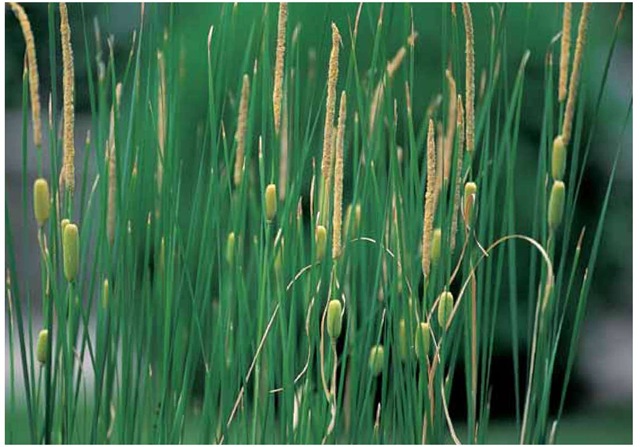
The narrow-leaved European cattail, Typha laxmannii, is one of the species having a sterile segment separating the female (lower) and male (upper) portions of the inflorescence. This feature is helpful in distinguishing various species.
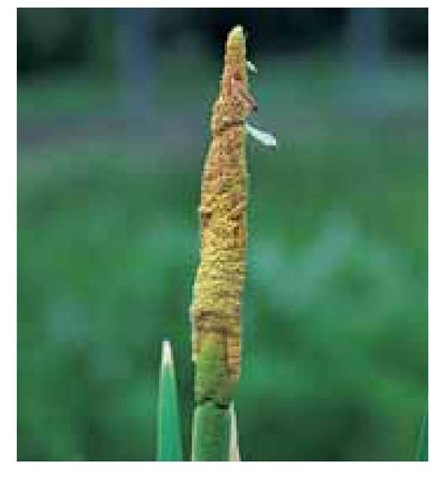
The inflorescence of Typha latifo-lia has the male section positioned directly above the female section, with no sterile segment in between. At the peak of pollen production in this June photo, male flowers appear gold.
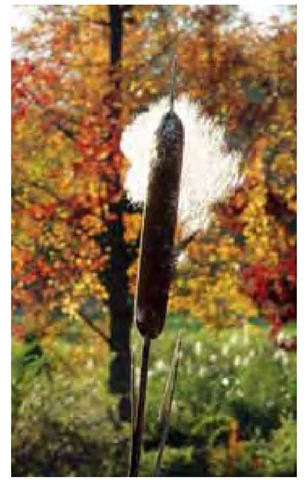
The late-October breeze helps disperse hairy seeds of Typha latifolia as red maples, Acer rubrum, reach the peak of their autumn color in a Delaware wetland.
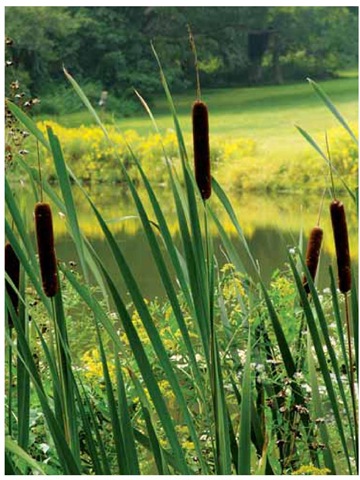
The familiar brown spikes and swordlike foliage of common cattail, Typha latifolia, mingle with goldenrods and asters edging a pond at Winterthur Museum and Gardens in northern Delaware in mid September.
